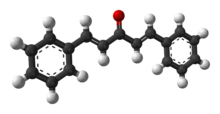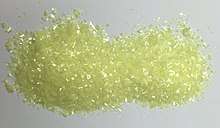Dibenzylideneacetone
Dibenzylideneacetone or dibenzalacetone, often abbreviated dba, is an organic compound with the formula C17H14O. It is a pale-yellow solid insoluble in water, but soluble in ethanol. Dibenzylideneacetone is used as a component in sunscreens and as a ligand in organometallic chemistry.
-1%2C5-diphenylpenta-1%2C4-dien-3-one_200.svg.png) | |
 | |
 | |
| Names | |
|---|---|
| IUPAC name
(1E, 4E)-1,5-Diphenylpenta-1,4-dien-3-one | |
| Other names
Dibenzalacetone | |
| Identifiers | |
| |
3D model (JSmol) |
|
| ChEMBL |
|
| ChemSpider | |
| ECHA InfoCard | 100.126.050 |
PubChem CID |
|
| UNII |
|
| |
| |
| Properties | |
| C17H14O | |
| Molar mass | 234.29 g/mol |
| Appearance | Yellow solid |
| Melting point | |
| Boiling point | 130 °C (266 °F; 403 K) (cis, cis isomer)[2] |
| insoluble | |
| Hazards | |
| Main hazards | Irritant |
Except where otherwise noted, data are given for materials in their standard state (at 25 °C [77 °F], 100 kPa). | |
| Infobox references | |
It was first prepared in 1881 by the German chemist Rainer Ludwig Claisen (1851–1930) and the Swiss chemist Charles-Claude-Alexandre Claparède (14 April 1858 – 1 November 1913).[3][4][5]
Preparation
The trans,trans isomer can be prepared in high yield and purity by condensation of benzaldehyde and acetone with sodium hydroxide in a water/ethanol medium followed by recrystallization.[1]
This reaction, which proceeds via the intermediacy of benzylideneacetone, compound is often prepared in organic chemistry classes.
Reactions and derivatives
Prolonged exposure to sunlight initiates [2+2] cycloadditions, converting it to a mixture of a dimeric and a trimeric cyclobutane cycloadduct.[6]
Dibenzylideneacetone is a component of the catalyst tris(dibenzylideneacetone)dipalladium(0). It is a labile ligand that is easily displaced by triphenylphosphine, hence it serves a useful entry point into palladium(0) chemistry.
References
- Conard, C. R.; Dolliver, M. A. (1943). "Dibenzalacetone". Organic Syntheses.; Collective Volume, 2, p. 167
- Merck index
- Claisen, L.; Claparède, A. (1881). "Ueber Verbindungen des Acetons und Mesityloxds mit Benzaldehyd und über die Constitution des Acetophorons" [On compounds of acetone and mesityl oxide with benzaldehyde and on the composition of phorone]. Berichte der Deutschen Chemischen Gesellschaft (in German). 14: 349–353. doi:10.1002/cber.18810140182. ; see pp. 350–351.
- Claisen wrote that the German chemist Adolf Baeyer might have synthesized dibenzylideneacetone as early as 1866, although the evidence wasn't clear.
- (Claisen & Claparède, 1881), p. 350: "Die Einwirkung wasserentziehender Mittel auf ein solches Gemenge ist schon von Baeyer1) flüchtig untersucht worden. Nach ihm entsteht als Endprodukt ein gelbes, in Alkohol unlösliches Harz, als Zwischenprodukt ein ölförmiger, unzersetzt siedender und cumarinartig riechender Körper, der, wie er meint, das Methylketon der Zimmtsäure darstellt." (The effect of a dehydrating agent on such a mixture has already been briefly investigated by Baeyer1). According to him, a yellow resin [that's] insoluble in alcohol arises as a final product, [and] as an intermediate, [there arises] an oily substance [which] boils without decomposing and smells like coumarin [and] which, he thinks, represents the methyl ketone of cinnamic acid.)
- Baeyer, Adolf (1866). "Ueber Condensation und Polymerie" [On condensation and polymerism]. Annalen der Chemie und Pharmacie (in German). 5 (Supplement): 79–95. ; see p. 82. From p. 82: "Um für diese Ansicht noch einen weiteren Beweis beizubringen, habe ich ein Gemenge von Bittermandelöl und Aceton mit wasserentziehenden Mitteln, Salzsäure, Schwefelsäure, Kali behandelt. Die Condensation erfolgt ausserordentlich schnell, schon nach wenigen Minuten, und nach einiger Zeit verharzt die ganze Masse. Das Endproduct ist ein gelbes Harz, das in Aether löslich und durch Alkohol daraus als gelbes Pulver gefällt wird, welches schwach nach Rhabarber riecht. Die Analyse gab keine verständlichen Zahlen, daher ist die Substanz wahrscheinlich ein Gemenge. Zuerst bildet sich aber ein öliger, unzersetzt flüchtiger Körper, der einen an Cumarin erinnernden Geruch besitzt, und der höchst wahrscheinlich das Methylaceton der Zimmtsäure ist: … ." (In order to provide further proof for this view, I have treated a mixture of benzaldehyde and acetone with dehydrating agents [e.g.,] hydrochloric acid, sulfuric acid, potash. The condensation occurs extraordinarily quickly, after just a few minutes, and after some time the whole mass becomes resinous. The final product is a yellow resin, which [is] soluble in ether and is precipitated therefrom by alcohol as a yellow powder, which smells faintly of rhubarb. Analysis [to determine its empirical formula] produced no intelligible numbers, so the substance is probably a mixture. Initially, however, an oily, stable, volatile substance is formed, which has a smell recalling coumarin, and which is very likely the methyl acetone of cinnamic acid: … .)
- For biographical information about Charles-Claude-Alexandre Claparède (with photograph), see: Reverdin, Frédéric (1914) "Dr. Alexandre Claparède. 1858–1913," Verhandlungen der Schweizerischen Naturforschenden Gesellschaft: Nekrologe und Biographien verstorbener Mitglieder … (Proceedings of the Swiss Society of Natural Sciences: Obituaries and biographies of deceased members … ), 96 : 22–27. (in French)
- Rao, G. N.; Janardhana, C.; Ramanathan, V.; Rajesh, T.; Kumar, P. H. (November 2006). "Photochemical Dimerization of Dibenzylideneacetone. A Convenient Exercise in [2+2] Cycloaddition Using Chemical Ionization Mass Spectrometry". J. Chem. Educ. 83 (11): 1667. Bibcode:2006JChEd..83.1667R. doi:10.1021/ed083p1667.
